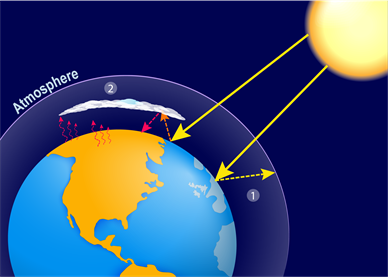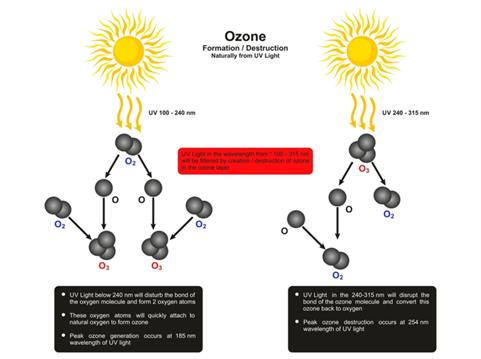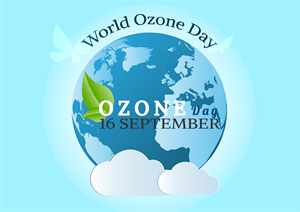PDF chapter test TRY NOW
The triatomic molecule of oxygen is known as ozone (). The ozone layer is also called the ozonosphere. It is the upper atmosphere region, which is 9 and 22\ miles above the earth’s surface, containing relatively high ozone molecules concentrations. This layer is present in the stratosphere.
 |
The ozone was discovered by French physicists Charles Fabry and Henri Buisson in 1913. According to seasons and geographic regions, the thickness of the ozone layer differs.
In the stratosphere, the temperature increases with an increase in height due to the absorption of solar radiation by the ozone layer.
The ozone layer blocks almost all solar radiation of wavelength less than 290\ nanometers from reaching the earth’s surface, including ultraviolet (UV) and other forms of radiation that could injure or kill most living things. Ozone is poisonous and unstable gas near the surface of the earth.
Fact: In our solar system, Venus also has a thin ozone layer.
 |
Formation of ozone layer:
The UV radiation is from 100-240nm; this photon energy disrupts the bond in the oxygen molecule and breaks it. The following are the steps involved in ozone formation.
Step 1: The breaking down of chemical bonds within the oxygen molecules by high-energy solar photons results in the free oxygen atoms.
Step 2: The single oxygen atom reacts with the oxygen molecules forming ozone.
The overall reaction is . This process of ozone formation is called photodissociation.
Depletion of ozone layer:
The UV radiation is from 240-315nm. This photon energy disrupts the bond in the ozone molecule and breaks it.
The breaking down of chemical bonds within the ozone molecules by high-energy solar photons and resulting in oxygen molecules.
Step 1:
Step 2:
The overall net reaction destruction of ozone is
 |
Causes of ozone depletion:
The thinning of the ozone layer or depletion is caused due to various factors such as modernisation techniques, industrialisation etc.
1. Man-made cause
The chemicals that release chlorine and bromine when exposed to intense ultraviolet light in the stratosphere are called as ozone-depleting substances (ODS).
Chlorine and bromine are found to be stable and in the earth's atmosphere, but they can float and remain static in the stratosphere, and they can react at supersonic speeds, causing ozone depletion.
Fact: One chlorine atom has the capacity to break one lakh of ozone molecules.
The chemicals such as chlorofluorocarbons (CFCs), carbon tetrachloride, hydrochlorofluorocarbons (HCFCs), methyl chloroform, brominated fluorocarbons (halons) are known as ozone-depleting substances.
These ODS are commonly used for cold cleaning, vapour degreasing, chemical processing, adhesives, aerosols, fire extinguishers, solvents, etc. They are found in appliances such as freezers, refrigerators, air conditioners etc.
2. Natural cause
The volcanic eruptions, stratospheric winds, and sun-spots (dark in colour and cooler region of the sun) are natural phenomena for ozone depletion.
Still, the percentage of depletion is 1-2\%, significantly less than the man-made cause of depletion.
Effect of ozone depletion:
The effect of ozone depletion can lead to severe impacts for all life forms on earth. When harmful radiation enters the earth's surface, it can cause cancer, cataracts, and immune deficiency disorders.
Also, it affects materials such as plastics, wood, rubber etc., where it will degrade them to a more considerable extent.
 |
Prevention of ozone depletion:
- Prohibit the Use of harmful ozone-depleting substances or chemicals
- Use of eco-friendly products for all needs
- Usage of public transport
- Green agriculture
